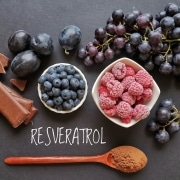What to Look for in a Meal Replacement and How They Can Help Your Health

Life is busy. And often the easiest foods to find come from the drive-through or a package. The problem is that these are often low in protein, fiber, and micronutrients. At the same time, the easy food options are often high in total calories—while not being very satisfying. These characteristics are the opposite of what to look for in a meal replacement. You want to make your meal replacements a healthy, on-the-go alternative to these unhealthy meals.
To fill this role, meal replacements need to be simple. That’s why the best meal replacements often take the form of a shake or a bar, which have minimal or no preparation. If an option is too complicated and time consuming to prepare, then you might go back to the unhealthy options.
The Nutrients to look for in a Meal Replacement
It’s not easy to have freshly prepared food with a balance of healthy fats, protein, and carbohydrates for every meal. The best meal replacements will provide a good balance of these macronutrients in an easy-to-eat form. This will vary depending on your goals and food preferences, but a healthy diet acquires roughly 20-35 percent of its calories from fat, 40-65 percent from carbs, and 15-25 percent from protein.
Applying that same balance to a 250-calorie meal replacement means it should have roughly 6-10 grams of fat, 25-41 grams of carbs, and 9-16 grams of protein. About three grams of those carbohydrates should be from fiber.
Those numbers are just guidelines. What’s most important is a meal replacement should still fit into your overall healthy eating goals. It could be a good opportunity to secure a little bit of extra fiber and protein that the rest of your diet may be lacking. So don’t worry if you see protein and fiber go beyond these general recommendations, but they should support your bigger daily goals.
The fat in a meal replacement should focus on healthier fats. This means it should generally limit saturated fats and contain more unsaturated fats. The fats in meal replacements often come from nuts and seeds—a much healthier choice than fried fats found in fast food. There are small amounts of naturally occurring trans fats in many foods, but the amount should be low enough that it rounds down to zero.
A normal, healthy meal that’s full of plant-based foods is also going to have lots of essential micronutrients. You should still be amassing some of these nutrients from your meal replacement, too. Look for a meal replacement that has a broad range of essential vitamins and minerals.
What are the Benefits of Meal Replacements?
Now you know what to look for in a meal replacement. Let’s assume you have found one that meets the above criteria, you like the flavor of, and have decided to incorporate it into your daily life. The real benefits will come from using it to replace the unhealthiest parts of your diet first.
A healthier meal on-the-go
Meal replacements are all about finding an easier way to have a nutritious diet. They aren’t meant to replace a well-balanced meal full of lean protein, vegetables, and whole grains. Instead, they aim to replace the unhealthy snacks and fast food that fill out your diet.
Why do people eat these unhealthy foods in the first place? Some of the foods do taste good, but people aren’t frequenting the corner fast-food joint due to their fine dining experience. A lot of it is due to convenience and routine.
The beauty of meal replacements is they are very easy to prepare. And that ease will help you turn meal replacements into part of your regular routine. So instead of a pastry with your morning coffee or the daily burger and fries for lunch, you can have a shake or bar instead.
Replacing fast food, chips, or candy with a meal replacement can help you increase your intake of essential nutrients like protein, fiber, vitamins, and minerals. At the same time, it can help limit the number of simple sugars, unhealthy fats, and total calories you eat. This is a win-win—giving you more nutrition in fewer calories.
Meal replacements instead of dieting
Yes, the act of eating a meal replacement does make it part of your diet. But compared to many of the traditional weight-loss diets, meal replacements have some distinct advantages.
As mentioned, the best meal replacements are easy to incorporate into your diet. Shakes require minimal preparation and bars don’t require any. The convenience of meal replacements also plays an important role in their ability to help people maintain a healthy weight.
Some of the top reasons people fail at weight-loss diets are due to their complicated nature. Many diets have you counting parts of the food you eat. Calories, fat, carbs, and protein are all important parts of your diet. But for most people it becomes tedious to track them and always be aware where you are at each point throughout the day.
Counting calories
If you have ever eaten out or at a family member’s house while trying to count calories, then you know the nightmare that can become. You are stuck with a few bad options. You can give up on goals for the day and eat what they have prepared. Or you can pick out the couple foods that you can guess accurately and eat some of those—but then go home still hungry.
This isn’t a viable long-term solution for most people. It leads to inconsistent results and eventually giving up on the diet.
It’s not encouraged to just bring a shake to dinner at your friend’s house. But you can plan ahead. Have a shake for lunch that same day, instead of eating both a large lunch and a large meal for dinner.
Even if you still end up eating more than you should on some days, meal replacements are tools for long-term success. Unlike most diets, the replacements are not about losing 10 pounds in the next month. They help you make better eating choices over the months and years of your life.
So after a big night out, rather than the internal debate about whether to continue your calorie counting or give up, you can go back to a simple meal-replacement for lunch. It’s not the most exciting or glamorous food. But the best meal replacements are convenient, and provide a choice you can lean on for years.
That’s great if counting calories works for you, or it’s something you want to do for a short while. These dietary approaches aren’t mutually exclusive. You can use meal replacements while you count calories. Just remember that weight maintenance is a life-long goal, and whatever works for you is going to have to be maintained throughout your life.
Counting carbs
Ketogenic diets are extremely popular right now. And for good reason—most people love an excuse to eat bacon and cheese all day.
Ketogenic diets have some legitimate benefits. Beyond the cheese and bacon, one of the big benefits people talk about is avoiding the calorie counting mentioned above. As already outlined, that task isn’t fun.
But the true followers of keto know that it’s not a diet that keeps you completely away from the counting game. To stay in ketosis, you need to keep your carb intake below about 10 percent of your total energy intake. That means you need to know your calorie intake AND your carb intake.
You could try to keep it simple by skipping the calorie counting, and just limit carbs to 50 g per day. But that won’t work for everyone. And those who do keep their carbs below 50 g per day will face a struggle common to keto diets.
That challenge is acquiring enough nutritious fruits and vegetables in your diet and 25-plus grams of fiber, all while staying below 50 g of carbs per day. It isn’t easy, especially without really tracking your diet carefully. Just like with calorie counting, this isn’t saying that keto diets are bad. Just that it’s more difficult to maintain for most people than turning to a quality meal replacement as a weight-management tool.
What to Look for in a Meal Replacement? What Works Best for You
The most important part of a healthy diet is finding what works for you. The balance of a good meal replacement makes them a great alternative to unhealthy snacks. And their simplicity makes the best meal replacements good alternatives to stricter diets.
Meal replacements aren’t perfect either, but it’s that lack of having to be perfect that makes them so easy to incorporate into your long-term goals. Whether you are trying to have an overall healthier diet or trying to maintain a healthy weight, longevity is essential.
Dieting for life is a marathon, not a sprint. And that’s what a meal replacement is designed for—a life-long addition to your diet.












